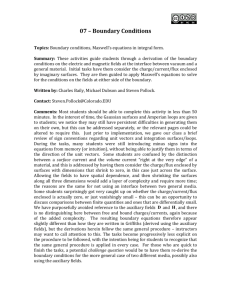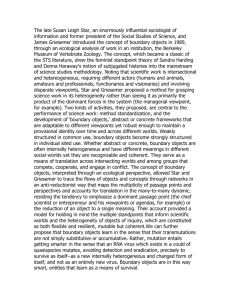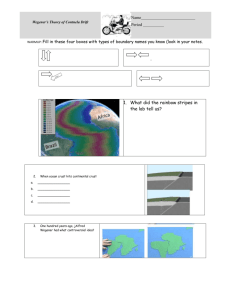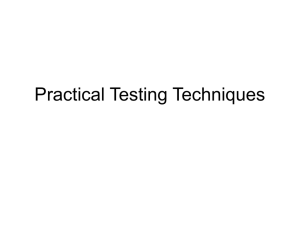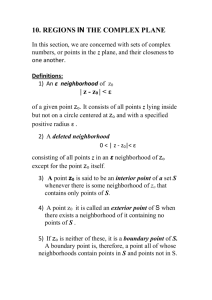Tutorial10_BoundaryC..
advertisement
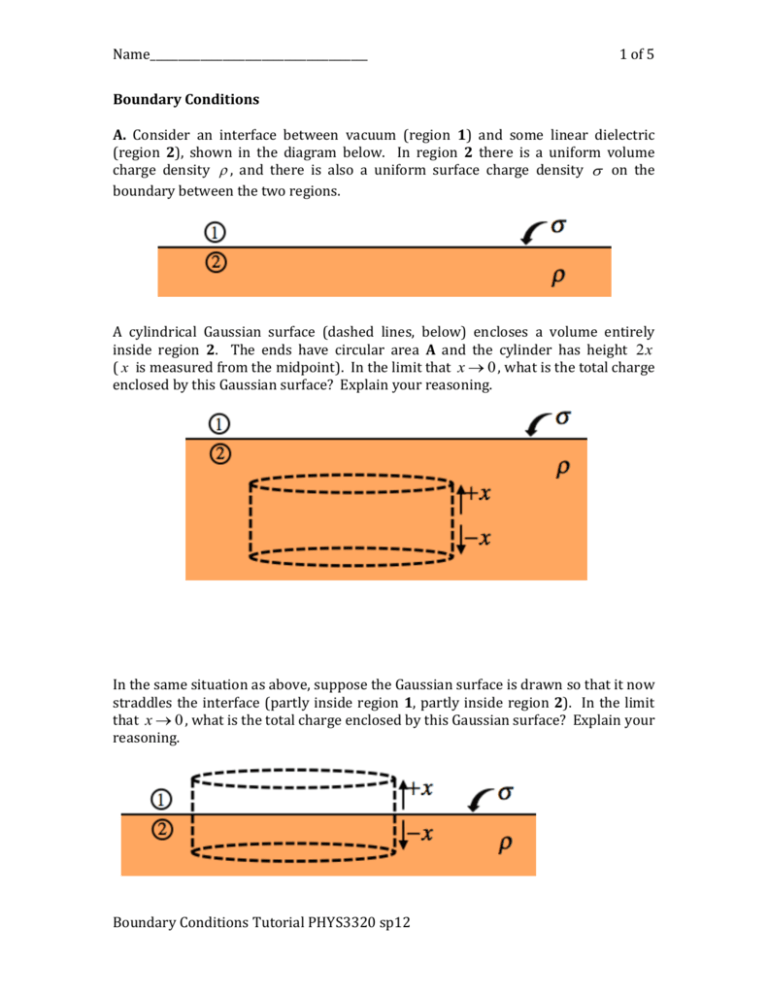
Name_______________________________________ 1 of 5 Boundary Conditions A. Consider an interface between vacuum (region 1) and some linear dielectric (region 2), shown in the diagram below. In region 2 there is a uniform volume charge density , and there is also a uniform surface charge density on the boundary between the two regions. A cylindrical Gaussian surface (dashed lines, below) encloses a volume entirely inside region 2. The ends have circular area A and the cylinder has height 2x ( x is measured from the midpoint). In the limit that x 0 , what is the total charge enclosed by this Gaussian surface? Explain your reasoning. In the same situation as above, suppose the Gaussian surface is drawn so that it now straddles the interface (partly inside region 1, partly inside region 2). In the limit that x 0 , what is the total charge enclosed by this Gaussian surface? Explain your reasoning. Boundary Conditions Tutorial PHYS3320 sp12 Name_______________________________________ 2 of 5 B. Imagine now that there are spatially uniform electric fields just above ( E1 ) and just below the surface ( E2 ). The field E1 is uniform within region 1, and E2 is uniform within region 2, but they are not necessarily equal. Use your results from the previous page and Gauss’ Law, E da 1 0 Qenclosed …to determine the boundary condition on E, the components of the electric field that perpendicular to the interface. Be sure to identify any area vectors that are relevant. C. Suppose the vectors in the diagram above instead represented spatially uniform magnetic fields B1 (just above the surface) and B2 (just below the surface). What would be the analogous boundary condition on B the perpendicular components of the magnetic field? Boundary Conditions Tutorial PHYS3320 sp12 Name_______________________________________ 3 of 5 D. Suppose that in addition to the same electric fields ( E1 & E2 ) there are timedependent, spatially uniform magnetic fields B1 t (just above the surface) and B2 t (just below the surface), both of which point out of the page. A rectangular Amperian loop (dashed lines, below) has length and width 2x ( x is measured from the midpoint), and is drawn so that it straddles the interface (partly inside region 1, partly inside region 2). The arrows along the loop represent the direction to be used for any line integrals. In the limit that x 0 , what is the total magnetic flux through the area enclosed by this Amperian loop? Explain your reasoning. d B da to determine the boundary dt condition on E||, the components of the electric field that are parallel to the interface. Use this result and Faraday’s Law: Ed Be sure to identify any unit vectors that are relevant. Boundary Conditions Tutorial PHYS3320 sp12 Name_______________________________________ 4 of 5 E. Imagine the same kind of interface between vacuum (region 1) and a linear dielectric (region 2). Inside region 2 there is now a uniform volume current density J , and a uniform surface current density K on the boundary, both of which point out of the page. A rectangular Amperian loop (dashed lines, below) encloses an area entirely inside region 2. The loop has length and height 2x ( x is measured from the midpoint). In the limit that x 0 , what is the total current enclosed by this Amperian loop? Explain your reasoning. F. In the same situation as above, suppose the Amperian loop is drawn so that it now straddles the interface (partly inside region 1, partly inside region 2). In the limit that x 0 , what is the total current enclosed by this Amperian loop? Explain your reasoning. Boundary Conditions Tutorial PHYS3320 sp12 Name_______________________________________ 5 of 5 G. Imagine now that there are spatially uniform magnetic fields just above ( B1 ) and just below the surface ( B2 ), both of which are pointing to the right. There are also time-dependent, spatially uniform electric fields E1 t & E2 t , both of which point out of the page. In the limit that x 0 , use the Maxwell-Ampere Law: Bd 0 I enclosed 0 0 d E da dt …to determine the boundary conditions on B|| , the parallel components of B above and below the surface. Be sure to identify any relevant unit vectors. Boundary Conditions Tutorial PHYS3320 sp12
